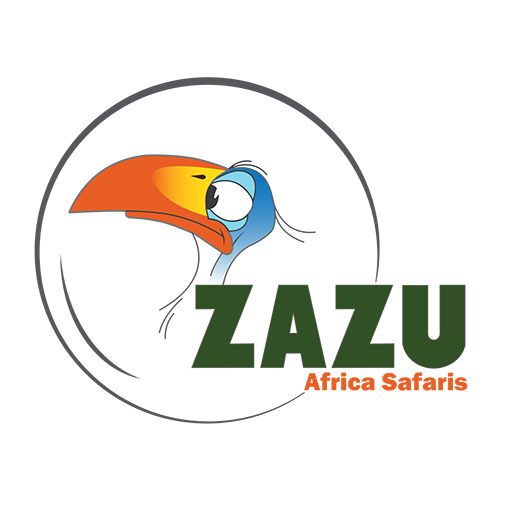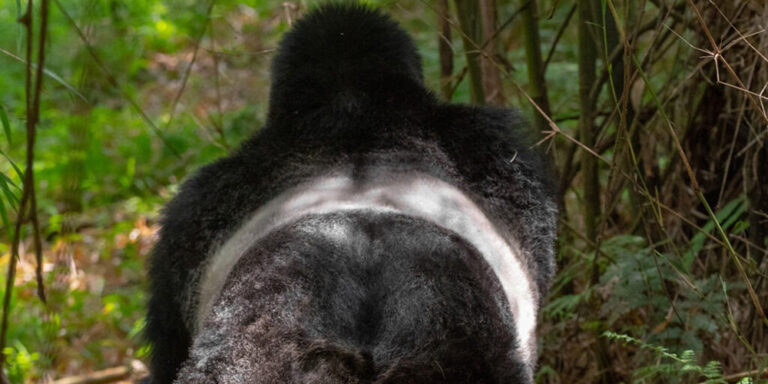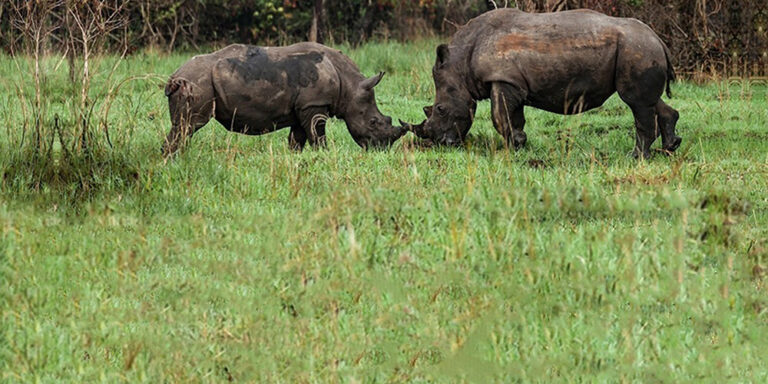What is the difference between Gorilla trekking and gorilla habituation?
What is the difference between Gorilla trekking and gorilla habituation? Gorilla trekking is a shorter and more common experience where visitors hike through the forest to spend one hour observing a habituated gorilla family. This ensures minimal human interference while allowing guests to see the gorillas in their natural environment.
Gorilla habituation, on the other hand, is a more in-depth experience, lasting four hours with a gorilla group that is still undergoing the habituation process. This offers a rare opportunity to observe the gorillas as they become accustomed to human presence and gain deeper insights into their behavior and social interactions.
The key differences between gorilla trekking and gorilla habituation are:
- Level of Participation and Immersion:
- Gorilla Trekking: Visitors observe and photograph gorillas from a designated distance of approximately 10 meters (32 feet) for one hour. The experience is primarily observational, allowing participants to admire the gorillas in their natural habitat.
- Gorilla Habituation Experience: This offers a more immersive opportunity, allowing visitors to actively participate in the habituation process. Guests spend up to four hours with the gorillas, gaining a deeper understanding of their behavior and social interactions. Visitors are accompanied by senior researchers from Uganda Wildlife Authority.
- Time and Duration:
- Gorilla Trekking: The activity lasts a few hours, including the hike to and from the gorilla family’s location, with only one hour spent in their presence.
- Gorilla Habituation Experience: This requires a greater time commitment, typically lasting over four hours, including both the trek and the extended observation period with the gorillas.
- Group Size:
- Gorilla Trekking: Each gorilla family can be visited by a group of up to eight tourists, making it a shared experience.
- Gorilla Habituation Experience: The group size is limited to a maximum of four tourists per gorilla family, allowing for a more intimate and exclusive interaction.
- Cost:
- Gorilla Trekking: Permit costs vary by country and residency. Foreign non-residents pay $800, $700 for foreign residents, $500 for African citizens, and Ugx300,000 for East African Citizens in Uganda, making it the more affordable option.
- Gorilla Habituation Experience: This experience comes at a higher price due to its exclusivity and extended duration. Permits cost $1,500 for foreign non-residents, $1,000 for foreign residents and African Citizens, and UGX 750,000 for East African citizens. The permits are purchased from the Uganda Wildlife Authority either directly or through a tour operator like (us).
- Physical Demands:
- Gorilla Trekking: Requires a moderate to high level of physical fitness, as trekkers must hike through dense forests and sometimes steep terrain to reach the gorillas.
- Gorilla Habituation Experience: Demands even greater endurance, as participants trek longer distances and spend more time in the forest, often navigating rugged and challenging landscapes.
- Purpose:
- Gorilla Trekking: Designed for visitors who want a shorter, yet incredible opportunity to observe and photograph gorillas in their natural habitat.
- Gorilla Habituation Experience: Offers a more in-depth, hands-on experience, allowing participants to contribute to the habituation process and gain deeper insights into gorilla behavior and social interactions.
Contact us for more information about gorilla trekking and habituation.
Choosing the Right Experience
- Opt for Gorilla Trekking if:
- You prefer a shorter, yet adventurous experience.
- You are comfortable with limited interaction time (one hour) with gorillas.
- You enjoy the thrill of tracking gorilla families through dense forests.
- You want a more affordable option compared to habituation.
- Opt for the Gorilla Habituation Experience if:
- You desire a deeper understanding of gorilla behavior and social dynamics.
- You want a more immersive and extended encounter (four hours).
- You have the physical endurance for prolonged trekking in challenging terrain.
- You wish to contribute to gorilla conservation efforts.
Both experiences provide incredible opportunities to observe and appreciate these majestic primates while supporting conservation efforts. The ideal choice depends on your interests, fitness level, time availability, and budget. Book your permits from the Uganda Wildlife Authority in advance to embark on the two adventures.
Where to Stay During Gorilla Trekking and Habituation in Bwindi Forest
For those embarking on the Gorilla Habituation Experience in Bwindi Impenetrable National Park, accommodation options are available in the Rushaga and Nkuringo sectors, where habituation takes place.
In Rushaga, visitors can stay at Rushaga Gorilla Camp, Four Gorillas Lodge, Rushaga Gorilla Havens Lodge, Nsongi Camp, Icumbi Gorilla Safari Lodge, Gorilla Safari Lodge, Gorilla Valley Lodge, or Karungi Camp. These lodges provide a comfortable stay close to the habituation trekking points.
In Nkuringo, travelers can choose from Nkuringo Bwindi Gorilla Lodge, Clouds Mountain Gorilla Lodge, or Lake Mutanda Resort. These lodges are also conveniently located near the starting points for Gorilla Habituation, ensuring easy access to the experience while offering scenic views and quality hospitality.
What to Pack for Gorilla Habituation in Bwindi Forest
Preparing for the Gorilla Habituation Experience in Bwindi Impenetrable National Park requires the right gear to ensure a comfortable and enjoyable trek. Given the dense forest, unpredictable weather, and rugged terrain, it’s essential to have appropriate clothing and equipment.
- A comfortable, durable pair of walking shoes or hiking boots is necessary, as the trails can be muddy and slippery, especially during the rainy season. Since some sections of the hike are steep and physically demanding, sturdy footwear will provide the needed support.
- Wearing a long-sleeved cotton shirt and lightweight long trousers is highly recommended to protect against the undergrowth, stinging nettles, and biting ants.
- Other essential items to pack include insect repellent to guard against mosquitoes and other insects, a torch or flashlight with spare batteries, and wet wipes for personal hygiene during the trek. A water bottle is crucial to stay hydrated throughout the journey.
- For capturing unforgettable moments, a camera with appropriate lenses is a must. Additionally, gardening gloves can help protect your hands while navigating through thick vegetation. Sandals, hiking shoes, or comfortable walking shoes can be useful for relaxing at the lodge after the trek.
- To shield yourself from the sun, bring a hat and sunscreen, and since rain is always a possibility, a rain jacket is essential. Evenings in Bwindi can be chilly, so a sweater or fleece will help keep you warm. If your accommodation offers a swimming pool, swimwear is a good addition to your packing list.
- For those interested in birdwatching or wildlife viewing, binoculars will enhance the experience, allowing for better visibility of birds and other wildlife in the park.
- Packing the right essentials will ensure a more comfortable and rewarding Gorilla Habituation Experience in Bwindi.
Best Time for Gorilla Trekking in Uganda
Gorilla trekking in Uganda is possible all year round, but the best time to visit is during the dry seasons, which run from June to August and December to February. These months offer the most favorable conditions for trekking, as the trails in Bwindi Impenetrable Forest and Mgahinga Gorilla National Park are drier, making hiking easier and more enjoyable.
Dry Season (Best Time) – June to August & December to February
- ✅ Easier trekking conditions – Less mud and slippery paths
- ✅ Better wildlife viewing – Gorillas are easier to track
- ✅ Mild temperatures – Cooler and more comfortable for hiking
- ✅ Peak tourist season – Higher demand for permits and accommodations
Wet Season (March to May & September to November) – More Challenging but Rewarding
- More challenging treks – Trails become muddy and slippery
- Fewer tourists – More availability of permits and lodges
- Better photography opportunities – Lush green scenery
- Gorillas stay closer – More food available in lower altitudes
If you prefer fewer crowds and lower costs, the wet season might be a good option. However, for the best trekking experience, the dry season remains the most recommended time for gorilla trekking in Uganda.
Would you like help planning your gorilla trekking safari? Contact us today to plan your best gorilla and wildlife safari
Habituation or Trekking Safari?
Embark on a once-in-a-lifetime journey to witness Uganda’s majestic gorillas while actively supporting their conservation with us. Whether you choose the thrilling Gorilla Trekking or the immersive Gorilla Habituation Experience, our expert team is here to tailor your adventure to perfection.
We handle everything—from securing permits and arranging accommodations to providing seamless transportation. Browse our carefully curated Uganda Gorilla Tours and start planning your unforgettable wildlife experience today!
Contact us to plan your adventure!



